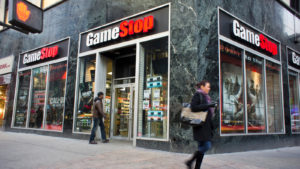When GameStop (NYSE:GME) reported earnings last week, options buyers were expecting a windfall from the dual PlayStation 5 and Xbox Series X release. Instead, all they got was dismay. Shares slid 20% even as the company reported less-than-expected losses. But don’t wait for a rebound in GameStop stock. It’s time to get out.

In a year where the novel coronavirus pandemic has gutted most brick-and-mortar companies, GameStop has emerged as an odd winner. Its stock is up 134% since September as excitement over next-gen consoles have reached a fever pitch. But with all great parties, this one must also end. As GameStop starts resembling Blockbuster rather than Best Buy (NYSE:BBY), investors should get out while they still can.
Consider the following before you continue to latch onto the stock:
- GameStop shares will reverse in the medium-term
- Bearish trades are too crowded
- Traders need to use covered options carefully
GameStop Stock: Short-Term Boost, Long-Term Peril
Investors in companies like GameStop and BestBuy have always recognized their bargain with the devil. Although both retailers faced growing competition from Amazon (NASDAQ:AMZN) and big-box stores, shares were so cheap that even failing less badly than expected could return their investment many times over.
And for almost a decade now, GameStop has confounded short-sellers by staying alive. It’s high margin used game business kept operating profits in the green, even as competitors like FYE collapsed. The long-awaited releases of the PlayStation 5 and Xbox Series X have added fuel to that fire. U.S. gaming hardware sales rose 58% in November as customers stocked out consoles in roughly 10 minutes, pulling GME’s fortunes along for the ride.
Look deeper, however, and the GameStop veneer is starting to crack. As customer attitudes have shifted in buying digital media online, GameStop has suddenly found itself on the losing side of history. This year, both the Xbox Series X and PlayStation 5 include versions without disc drives; users simply download games online. While the shift to online-only distribution won’t happen overnight, the two console makers have fired the killing shot.
Missing the (Steam) Boat on Technology
It didn’t have to be this way. Companies like Steam, owned by the Valve, jumped into the web-based world by selling games entirely online. With its first-mover advantage, the company now commands 75% of the world’s PC games distribution.
GameStop, on the other hand, has been comfortable living in the past. In 2013, the company successfully lobbied Microsoft (NASDAQ:MSFT) to ship its new Xbox One consoles with disc drives, prolonging the life of the used games business. And in 2020, GME boldly announced a multi-year strategic relationship with Microsoft that didn’t involve game distribution at all. Instead, a careful reader would have realized the partnership involved upgrading GameStop’s back-end to run Dynamics 365, Microsoft’s suite of cloud-based business services.
These flubs have caught the attention of activist investors, who have since replaced several board members with their own. But for all the table-pounding that these outsiders bring, it might be too late. Consumers already buy more digital games than physical ones, echoing the shift in technology that killed off Blockbuster years ago. And without used games to keep people coming into stores, it’s only a matter of time before GameStop’s other business lines start to fail.
How Should You Play GME Stock? Covered Options
Only now are investors starting to realize the depth of GME’s problems. When the company reported third-quarter earnings last week, it initially revealed a 16.5% comparable-store increase. A more in-depth read of financials, however, shows far worse news. Even after you include e-commerce sales and remove 11% of underperforming stores, comps still declined 24.6%. Management’s third-quarter hand-waving is the financial equivalent of entering a lipstick-wearing pig into a Ms. Universe pageant. Shares have slid another 10% since their Q3 announcement last week.
Retail investor involvement, however, makes GME stock challenging to handle. Implied volatility for Jan 15 calls hover around 165%, while puts are at 120%. And a quick check with Interactive Brokers (NASDAQ:IBKR) show just 38,700 shortable shares on the market, priced at a headache-inducing 47% interest rate. In other words, traders have only a few cheap courses of action.
One option is to write covered calls: short an in-the-money January call and buy a stock. That way, you can profit from the fat premiums of the call option while earning interest from your shorted shares (assuming your brokerage funnels you those fees). The problem is that you only have $2-3 of breathing room for GameStop stock to fall before losses start piling up.
Another option is to do a naked short (and hedge your bet with an out-of-the-money call). As long as you’re a retail investor, there should be enough shares available for a short-term trade. Institutional investors need not apply.
Finally, you could simply sit back and watch GameStop burn. While my heart goes out to the thousands of retail workers who will inevitably lose their jobs, my sympathy only goes so far up the food chain; GameStop’s top brass walked away with $35.2 million in compensation last year, even as the company’s business model was collapsing.
With over 100 days until the next earnings, a lot can still go wrong for GameStop stock and options holders. But in the end, GameStop is starting to look more like Blockbuster than Best Buy. It has been a great party, but it’s time to call a cab to go home.
On the date of publication, Tom Yeung did not have (either directly or indirectly) any positions in the securities mentioned in this article.
Tom Yeung, CFA, is a registered investment advisor on a mission to bring simplicity to the world of investing.
